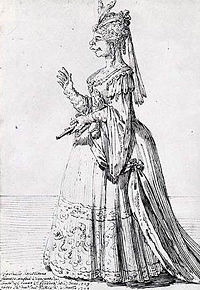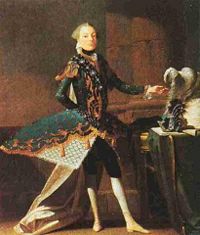Castrato
A castrato is a male, artificially produced soprano, mezzo-soprano, or alto singer whose voice is artificially changed through castration before puberty. This is done in order for the child to be more physically suited for advanced training as a singer. A castrato may also be one who, because of an endocrinological condition, never reaches sexual maturity. The practice was almost exclusively an Italian one, largely influenced by the Catholic church beginning in the mid-sixteenth century and lasting through the 1800s. Today, castratos are often regarded as a type of manufactured virtuoso, having been victims of, or slaves to, their craft.
Castrati were rarely referred to as such. More common was the term musico (pl musici). Another synonym used was evirato, literally meaning "unmanned." The term castrato generally carries a negative connotation, and is therefore the name used most frequently today, as a reflection of contemporary culture's disapproval of the once accepted practice. The custom had become generally banned by the late 1800s. The last castrato, Alessandro Moreschi, was born in 1858, and retired in 1913.
Castrati were no doubt a beautiful contribution to the higher art of western culture, but at the expense of the singer's right to live a normal life, including his capacity for sexual desire and to procreate. Thus, the tradition is clearly seen now as an example of humankind's distortion of cultural values.
Physiology
Castration before puberty (or in its early stages) prevents a boy's larynx from being transformed by the normal physiological events of puberty. As a result, the vocal range of prepubescence (shared by both sexes) is largely retained, and thus the voice develops into adulthood uniquely. As the castrato's body grows, his lack of testosterone causes his epiphyses (bone-joints) to not harden in the normal manner. Thus, the limbs of the castrati often grew unusually long, as did the bones of their ribs. This, combined with intensive training, gave castrati unrivaled lung-power and breath capacity. Operating through small, child-sized vocal cords, their voices were also extraordinarily flexible, and quite different from the equivalent adult female voice, as well as higher vocal ranges of the uncastrated adult male (such as a soprano, mezzo-soprano, alto, sopranist, countertenor or contralto). Listening to a castrato sing, one can hear that the lower part of the voice sounds like a "super-high" tenor, with a more falsetto-like upper register above that.
History of castration
Castration as a means of subjugation, enslavement, or other punishment has a very long pedigree, dating back to ancient Sumeria. In a Western context, eunuch singers are known to have existed from the early days of the Byzantine Empire. In Constantinople, around 400 C.E., the empress Eudoxia had a eunuch choir-master, Brison, who apparently employed the use of castrati in Byzantine choirs. By the ninth century, eunuch singers were well known (not least in the choir of Hagia Sophia), and remained so until the sack of Constantinople by the Western forces of the Fourth Crusade in 1204. Their fate from then until their reappearance in Italy more than three hundred years later remains unclear, though it is likely that the Spanish tradition of soprano falsettists may have hidden castrati. It should be remembered that much of Spain was under Arab domination at various times throughout the Middle Ages, and that eunuch harem-keepers, almost always taken from conquered populations, were commonplace of that society. By sheer statistics, some of them are likely to have been singers.
Castrati in the European Classical tradition
Castrati, many of them having Spanish names, first appeared in Italy in the mid-sixteenth century. Alfonso II d'Este, Duke of Ferrara, had become an early enthusiast by 1556. There were castrati in the court chapel at Munich by 1574, where the music director was Heinrich Schütz, and it is likely that Palestrina, director of the choir of St Peter's Rome from 1576 to 1594, would have been keen to emulate his famous contemporary. In 1589, Pope Sixtus V reorganized that choir specifically to include castrati, and in 1599, they were first admitted into the Pope's personal choir of the Sistine Chapel. Thus, the castrati came to supplant both boys (whose voices broke after only a few years) and falsettists (whose voices were weaker and less reliable) from the top line in such choirs. Women were banned by the Pauline dictum mulier taceat in ecclesia ("let your women keep silent in church;" I Corinthians, ch 14, v 34).
Castrati in opera
Castrati had parts in the earliest operas: In the first performance of Monteverdi's Orfeo (1607) they played subsidiary roles, including that of Euridice. By 1680, however, they had supplanted "normal" male voices in lead roles, and retained their hegemony as primo uomo for about a hundred years. Because of the popularity of Italian opera throughout eighteenth century Europe, castrato singers such as Ferri, Farinelli, and Pacchierotti became the first operatic superstars, earning enormous fees and public adulation. The strictly hierarchical organisation of opera seria favored their high voices as symbols of heroic virtue, though they were frequently mocked for their strange appearance and sub-par acting.
The training of the boys was rigorous. The regime of one singing school in Rome (c. 1700) consisted of one hour of singing difficult and awkward pieces, one hour practising trills, one hour practising ornamented passaggi, one hour of singing exercises in their teacher's presence and in front of a mirror (so as to avoid unnecessary movement of the body or facial grimaces), and one hour of literary study—all of this, moreover, before lunch. Afterwards, half-an-hour would be devoted to musical theory, another to writing counterpoint, an hour copying down the same from dictation, and another hour of literary study. During the remainder of the day, the young castrati had to find time to practice their harpsichord playing, and to compose vocal music, either sacred or secular depending on their inclination.[1] This demanding schedule meant that, if sufficiently talented, they were able to make a debut in their mid-teens with a perfect technique and a voice of a flexibility and power no woman or ordinary male singer could match.
In the 1720s and 1730s, at the height of the castrati craze, it has been estimated that upwards of 4000 boys were castrated annually in the service of art.[2] Many of these artists came from poor homes, and were more or less sold by their parents to the church or to a singing-master, in the hope that their child might be successful and lift them from their lowly status in society (as was the case for Senesino). There are, though, records of some young boys asking to be operated on to preserve their voices (such as Caffarelli, who was from a wealthy family). Not all castrated boys had successful careers on the operatic stage; the better "also-rans" sang in cathedral or church choirs, while some turned to the straight theater.
Decline
By the late eighteenth century, changes in operatic taste and social attitudes spelled the end for the castrati. They lingered on past the end of the ancien régime (which their style of opera parallels), and two of their number, Pacchierotti and Crescentini, even entranced the iconoclastic Napoleon. The last great operatic castrato was Giovanni Battista Velluti (1781-1861), who performed the last operatic castrato role ever written: Armando in Il Crociato in Egitto by Meyerbeer (Venice, 1824). Soon after this they were replaced definitively as the first men of the operatic stage by the new breed of heroic tenor as incarnated by the Frenchman Gilbert-Louis Duprez, the earliest "king of the high Cs," whose "descendants" are singers like Caruso, Franco Corelli, Luciano Pavarotti and Juan Diego Florez.
After the reunification of Italy in 1870, castration was officially made illegal, as the new Italian state had adopted a French legal code which expressly forbade such mutilations. In 1878, Pope Leo XIII prohibited the hiring of new castrati by the church: Only in the Sistine Chapel and in other papal basilicas in Rome did a few castrati still linger. A group photo of the Sistine Choir taken in 1898 shows that by then only six remained (plus the Direttore Perpetuo, the fine soprano castrato Domenico Mustafà), and in 1902, a ruling was extracted from Pope Leo stating that no further castrati should be admitted. The official end to the castrati came on St. Cecilia's Day, November 22, 1903, when the new pope, Pius X, issued his motu proprio, Tra le Sollecitudini ("Amongst the Cares"), which contained this instruction: "Whenever … it is desirable to employ the high voices of sopranos and contraltos, these parts must be taken by boys, according to the most ancient usage of the Church." The last Sistine castrato to survive was Alessandro Moreschi, the only castrato to have been recorded. On Moreschi, critical opinion varies between those who think him mediocre and only interesting as a historical record of the castrato voice, and others who regard him as a fine singer, judged on the practice and taste of his own time. He retired officially in 1913, and died in 1922.
Modern castrati and similar voices
So-called "natural castrati" are born with hormonal anomalies, such as Kallmann's syndrome, that reproduce the vocal effects of castration without the surgeon's knife. Javier Medina is an example of this type of high male voice. Others, like Michael Maniaci and Jorge Cano, have no hormonal or other anomalies, but for whatever reason their voices did not "break" in the usual manner, leaving them still able to sing in the soprano register. Other uncastrated male adults sing soprano, generally using some form of falsetto, but in a much higher range than the more common countertenor. Examples are Aris Christofellis, Radu Marian, Jörg Waschinski, Vitas, and Ghio Nannini. All these are gifted performers, but it must be remembered that, having been born in the twentieth century, they and the few others like them have not undergone the type of rigorous training through adolescence endured by the castrati of the eighteenth century. Thus their technique is distinctly "modern," and they lack the tenorial chest register that the castrati possessed. An exception is the remarkable jazz singer, Jimmy Scott, who uses only the low register, matching approximately the range used by female blues singers.
Antonio Maria Bononcini: Vorrei pupille belle, sung by Radu Marian
Javier Medina Avila, including an audio sample (Riccardo Broschi: Ombra fedele anch'io)
The importance of castrati in music
In the years that women were forbidden on stage, castrati were crucial in filling soprano spots in operas and for playing the roles of female characters. With the high voice of a prepubescent boy and the lung power of a man, there was no natural match to the castrato's singing capacity. Once women were allowed to perform, castrati, despite the extra aspect of beauty they added to the scene, were not technically necessary. Today their legacy is nothing more than a reminder of the cruel methods by which human culture once cultivated beauty. In that light, they serve as evidence of humanity's progression as a civilized race.
The process and complications of castration
Castration was performed by cutting the blood supply to the testicles, or by simply amputating them. The male child was placed in a warm bath to soften the testes and the operation was performed once the patient was rendered unconscious. Although castration did little to damage a castrato's intellect, it did pose serious health and emotional problems otherwise. Most castrati suffered from the effects of developmental hypogonadism, including an infantile penis and underdeveloped prostate. They also had a greater presence of subcutaneous fat than the normal male, as well as fat deposits localized on the hips, buttocks, and breast areas, and also fatty deposits on the eyelids. These excess deposits of fat often caused their skin to appear wrinkled or swollen.
Castrati tended to be volatile, conceited, and almost impossible to get along with. Composer George Frederick Handel’s notorious shouting matches with his castrato Senesino, for instance, were well-known throughout England. Many of the castrati’s well-documented personality disorders were a direct result of their disfigurement, as well as their inability to lead normal sex lives. Despite public admiration for their singing, they were also prone to much ridicule regarding their physical condition.
Castrati and the Catholic church
The Catholic Church's involvement in the castrato phenomenon has long been controversial, and there have recently been calls for it to issue an official apology for its role. As long ago as 1748, Pope Benedict XIV tried to ban castrati from churches, but such was their popularity at the time that he realized that doing so might result in a drastic decline in church attendance.
In popular culture
- The Franco-Italian film, Farinelli, deals with the life, career, frustration, and brother (a director-composer) of the castrato Carlo Broschi (stagename Farinelli). His voice was "reconstructed" by a mixture of counter-tenor and female soprano, and the film takes enormous liberties with history in the pursuit of cinematic effect.
- The disinterment of Farinelli's body in 2006 for scientific analysis was widely reported.
- Anne Rice's novel, Cry to Heaven, although a romantic novel, is based upon solid research and, notwithstanding the novelization, captures a strong sense of the training and world of castrato singers in eighteenth century Venice and Naples.
- Kingsley Amis's novel, The Alteration, deals in part with Hubert Anvil, a ten-year-old singer in the choir of St. George's Basilica, Coverley, whose mentors decide his voice is too precious to lose and that he should become a castrato (hence the title). The novel's setting is an imaginary Europe where the Reformation never took place.
- The Last Castrato is a psychological thriller about two young boys, fraternal twins, who must suffer castration for their art.
- In Russell T Davies' 2005 version of Casanova, Nina Sosanya played Bellino, a woman pretending to be a castrato, whose true sex was, however, eventually revealed.
- Jeanette Winterson's novel, Art & Lies, includes a subplot dealing with castration, eroticism, and the Church.
- A "castrato" accompanied a live orchestra, Foley Artists, and an interlocutor (Crispin Glover or Isabella Rossellini in some performances) in viewings of the 2006 film, Brand Upon The Brain!
Some famous castrati
- Baldassare Ferri (1610–1680)
- Antonio Maria Bernacchi (1685–1756)
- Francesco Bernardi (Senesino) (1686–1758)
- Carlo Broschi (Farinelli) (1705–1782)
- Gaetano Majorano (Caffarelli) (1710–1783)
- Giovanni Manzuoli (1720–1782)
- Gaetano Guadagni (1725–1792)
- Gasparo Pacchierotti (1740–1821)
- Luigi Marchesi (1754–1829)
- Girolamo Crescentini (1762–1848)
- Giovanni Velluti (1781–1861)
Notes
ReferencesISBN links support NWE through referral fees
- Bontempi, G. Historia Musica. Perugia, 1695.
- Casanova, G. Memoirs. Translated by A. Machen. London, 1894.
- Clapton, N. Moreschi, the Last Castrato. London, 2004.
- Haböck, F. Die Kastraten und ihre Gesangskunst. Berlin, 1927.
- Heriot, A. The Castrati in Opera. London, 1956.
- Scholes, P., ed. Dr Burney's Musical Tours in Europe. London, 1959.
- Pleasants, H. "The Castrati." Stereo Review, July 1966.
- Rosselli, J. The Castrati as a Professional Group and a Social Phenomenon, 1550-1850. Basel, 1988.
- Moran, N. Byzantine castrati. Cambridge, 2002.
- Tougher, S., ed. Eunuchs in Antiquity and Beyond. London, 2002.
External links
All links retrieved November 29, 2023.
- All you would like to know about Castrati
- Jorge Cano, A Contemporary Castrato
- Castrados por amor al arte
Credits
New World Encyclopedia writers and editors rewrote and completed the Wikipedia article in accordance with New World Encyclopedia standards. This article abides by terms of the Creative Commons CC-by-sa 3.0 License (CC-by-sa), which may be used and disseminated with proper attribution. Credit is due under the terms of this license that can reference both the New World Encyclopedia contributors and the selfless volunteer contributors of the Wikimedia Foundation. To cite this article click here for a list of acceptable citing formats.The history of earlier contributions by wikipedians is accessible to researchers here:
The history of this article since it was imported to New World Encyclopedia:
Note: Some restrictions may apply to use of individual images which are separately licensed.


